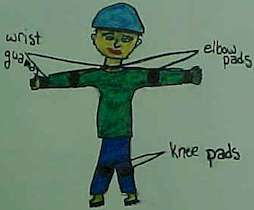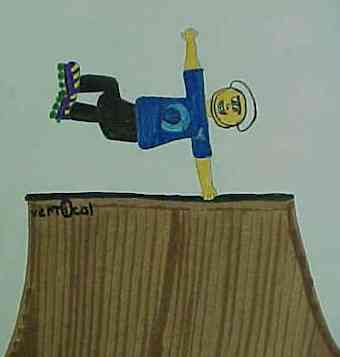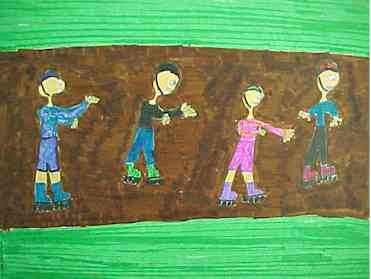| Inline-skating is fun for many people. Some people skate to be in competitions and do stunts, while some just skate for fun and exercise. If this sport sounds fun to you, try it, and you'll be one of millions of people who enjoy in-line skating. | |
About the Skate Skates have 5 basic features including the boot, liner, frame, wheels, and brake. Some boots are made of leather, polyurethane, or Kevlor. The boot is also called "the shell". Inside the boot is the liner. Most of the time it is made of foam wrapped around nylon cloth. Memory foam molds to fit your foot and is more expensive. |
|
| The brake is attached to the back of the
skate, and juts out behind it. The brake is made of hard rubber. The brake
should not be removed from the skate. Another part of the skate is the frame.
The frame is connected to the bottom of the boot. It holds the wheels in-line.
It is mostly made of aluminum, nylon or titanium. It should always be rigid.
The frame should never be bent. The last and most important part of the skate is the wheels. Different skates have wheels that have a different number, hardness, and size. The more wheels there are, the more stability the skate has. However, it makes it harder to turn. You can do many different activities using skates. There are many different kinds of skates, such as racing, dance, hockey and trick. Longer skates are used for racing skates and advanced skates, while shorter skates are for novice skaters and are easier to use. |
|
|
History The name "Rollerblade," came from the 1980 Olsen brother's company, 'Rollerblade'. Scott and Brennan Olsen invented a skate in their basement in 1979. These skates had only a little support. The brothers fixed that by adding better wheels and support. Joseph Merlin became a great part of history by inventing the very first skate. He was a great ice skater in the 1700s, and wanted to practice in the summer. So Joseph put on his thinking cap and came up with the idea of putting wooden spools on his shoes. The idea was good, but the "skates" could not turn or stop, so of course he fell a lot. Performers started doing shows on the skates, but many rolled right into the audience. In the 1790s, a frenchman named Vamlende invented another type of skate. This one had four wheels side-by-side. |
| Stunts
Many people think of skating as a display of tricks. Not all skating is in the department of tricks, but much is. Pavement, walls, and steps are what people usually practice stunts on. Most of the time the tricks are performed in contests, but some people just do it for fun. Jumps and spins are great for beginners. Beginners are not qualified to be in competitions; those are just for advanced skaters. The only two types of blading that are performed in competitions are the streetstyle and vert on the half-pipe (a big U-shaped ramp). |
|
| The streetstyle skaters will
compete on walls, pipes, ramps and jumps, while vert skaters do their stunts on a huge
half-pipe, which is 25 feet across and 10 feet high on each end. The judge will
score on style, difficulty, and creativity. Another stunt called ‘Japan Air’ is very hard. You need a lot of momentum and lots of speed to get up in the air for the trick. The ‘Mute Grab’ is done off a launch box, a type of ramp. Other objects used for stunts are riding stairs and grinding rails. |
|
 |
Safety
You should never skate without safety gear. A set would include a helmet, two wrist guards, two knee pads, and two elbow pads. Your helmet will protect you from things falling from trees, falling over and hitting your head, or from hitting your head on a wall. The wrist guards will take the impact from the fall if you fall on your wrist. If you don’t wear them, you could break your wrist. The knee pads will protect your knees from scratches or getting skinned knees. The elbow pads do the same as the knee pads, but are for your elbows. You should never skate over twigs, gravel or sticks, or anything like that. The twigs, sticks or gravel can get caught in your skates and make you fall. |
Racing Speed skaters can reach speeds of 25 mph on flat land. On hills, they can get up to 35 mph going downhill. Most rollerblade races are 10 kilometers, or 6.2 miles. There are also sprints of 200-500 meters. A 500 meter race is about one-third of a mile. There are also races of 31-62 miles. |
|
|
Bibliography Edwards, Chris. The Young In-line Skater. New York: DK Publishing, 1996. Savage, Jeff. In-line Skating Basics. Mankato, MN: Capstone Press, 1996. Sullivan, George. In-line Skating A Complete Guide For Beginners. Dutton, New York: Cobblehill Books, 1993. Tomlinson, Joe. Extreme Sports. New York: Smithmark Publishers, 1996. |
|
| Go to Top of Page | |



